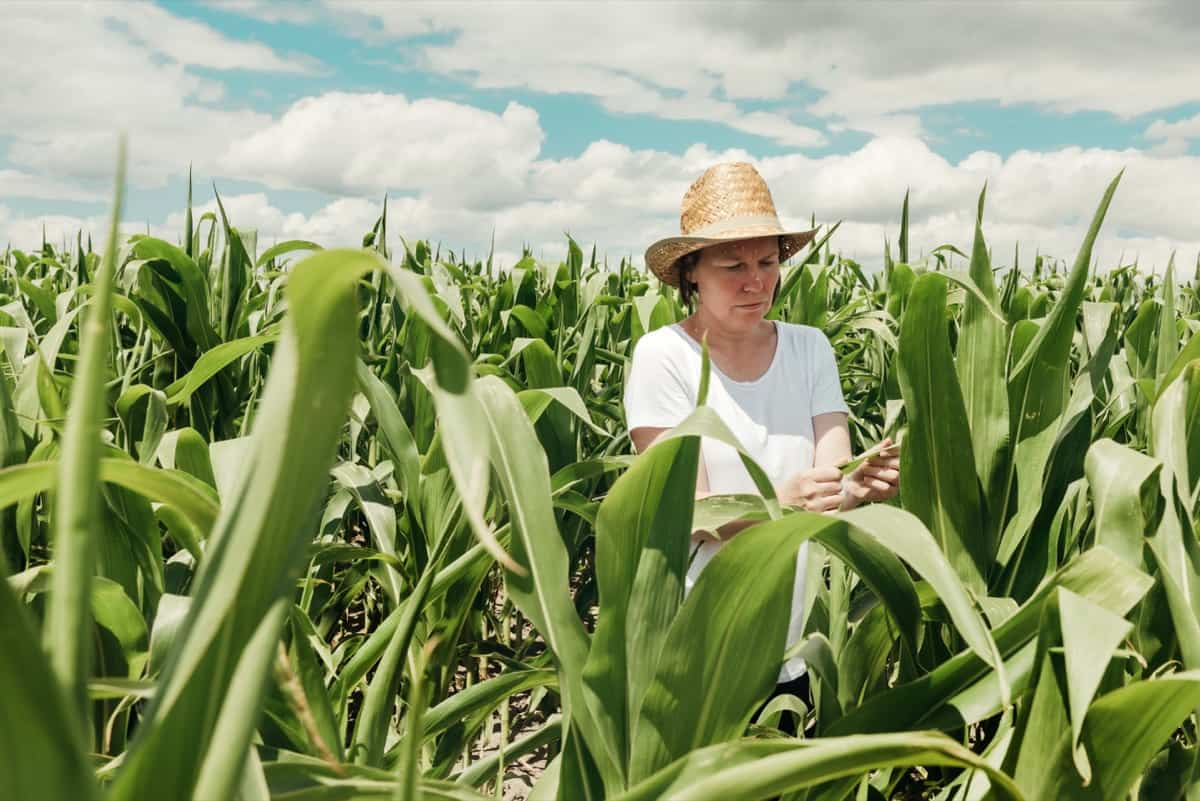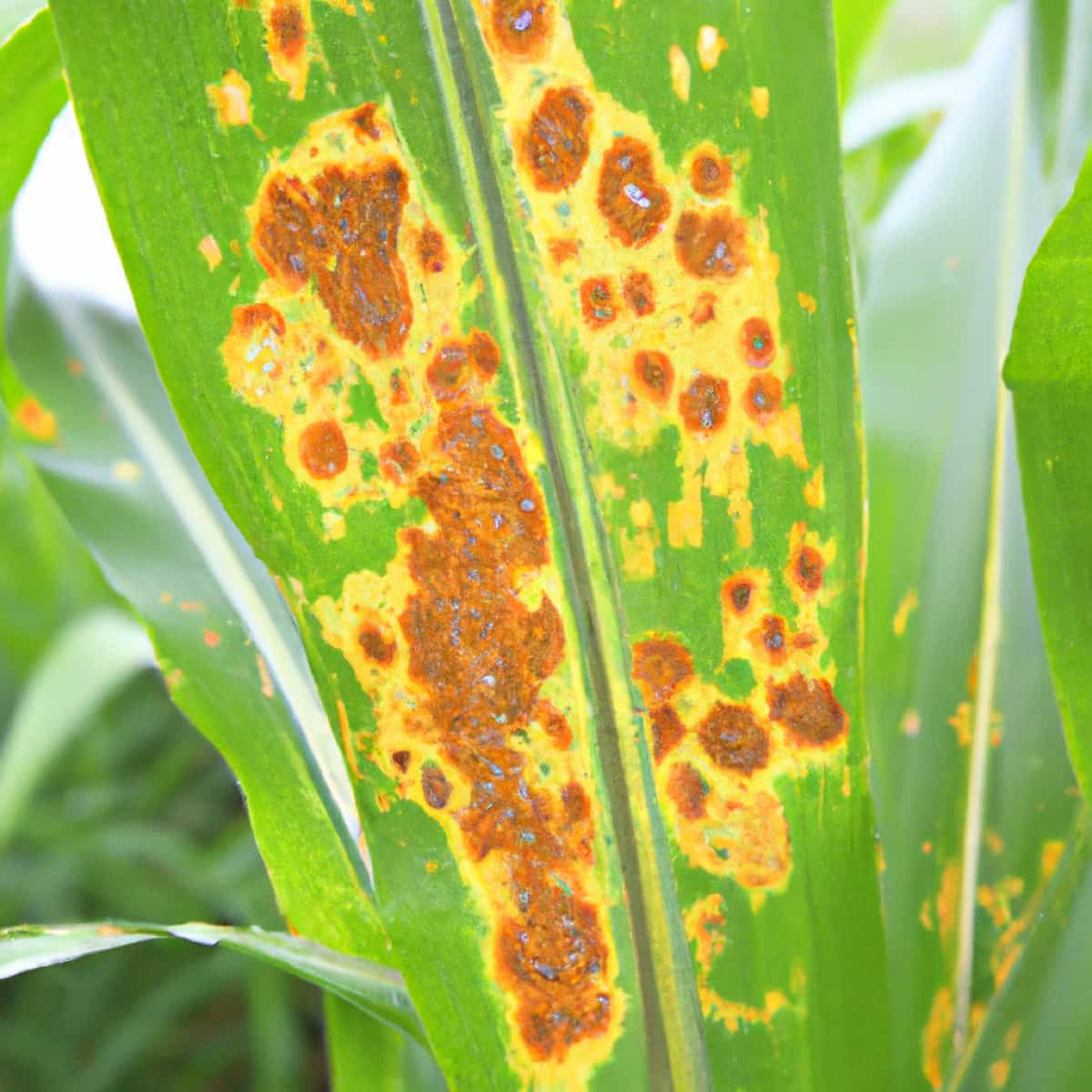The Maize Rust Disease is a fungal disease of maize caused by species in the Puccinia genus and is also known as common corn rust. This disease affects the leaves, stems, and husks of maize or corn and can cause significant yield losses. Maize rust is a widespread and economically important disease with the potential to cause significant damage to maize crops.

To effectively manage this disease, it is important to understand its disease cycle, the mode of disease spread, and the best methods for controlling it. This article will provide an overview and discussion of the Maize Rust Disease in Maize crops, including its symptoms, identification techniques, and control.
Maize Rust Disease Management
The Causal Organism of Maize Rust Disease
- Puccinia sorghi is an obligate parasite that belongs to the Family Pucciniaceae, Order Pucciniales of the Phylum Basidiomycota.
- It lives as a hemibiotroph, initially as a biotroph, and then changes to a necrotroph in the later stages of the disease.
- The fungus survives as tiny, reddish-brown pustules on the leaves of maize plants.
The Disease Cycle of Maize Rust Disease
The disease cycle begins with the primary infection by uredospores, which occurs during the growing season when the wind spreads the fungus spores from infected plants. These spores settle on the leaves, where they germinate and penetrate the epidermal cells of the leaves. Once inside the cells, the fungus reproduces, releasing more spores into the air.
The next stage of the disease cycle is the spread of the disease. During this stage, the fungus can spread to other parts of the maize plant and nearby maize plants. The fungus can spread through wind, rain, and contact with other infected plants. The third stage of the cycle is the formation of rust pustules. In this stage, the fungus produces small reddish-brown lesions on the leaves and other plant parts. These lesions contain spores that can be spread to other plants, leading to more infection.
The fourth stage is the production of fungal spores. During this stage, the fungus produces large spores that can be spread to other plants. The wind currents carry these spores to other maize plants. The final stage of the disease cycle is secondary infection. The fungus infects the maize plant’s kernels and cob during this stage. This can lead to significant yield losses, as the kernels and cob are the economical parts harvested for food.
Occurrence of Maize Rust Disease in Maize Crop
- Location of Maize Rust disease: This disease occurs in maize crops in Africa, India, Bangladesh, the USA, Mexico, Argentina, Brazil, Thailand, Spain, Italy, and France.
- Host range: The most common crops affected by rust are maize, sorghum, pearl millet, finger millet, rice, wheat, and sugarcane.
Favorable Conditions for Maize Rust Disease Spread in the Field
- The optimum conditions for maize rust development are cool temperatures of 10-15°C and high relative humidity of 90%.
- High humidity and prolonged periods of leaf wetness by rain or dew can also increase the risk of infection.
- Poor soil fertility can also create favorable conditions for maize rust disease spread.
- The optimum temperature required for the germination of conidia is 10-12°C.
Damage Symptoms of Maize Rust Disease
- Maize rust can be identified by its characteristic reddish-brown lesions on the leaves, which can sometimes dry and appear as a powdery substance.
- The infection results in yellowish-orange pustules on the leaves on both sides and husks, which can cause the plant to become stunted and deformed.
- Infected plants typically show yellowish-brown leaf lesions, which can eventually be covered in reddish-brown pustules. The leaves may also become distorted and curl up.
- As the disease progresses, the pustules turn black since black teliospores will replace the red uredospores.
In case you missed it: Maize/Corn Downy Mildew Disease Management: Symptoms, Treatment, Chemical, Biological, Natural, and Organic Control

Percentage of Yield Loss due to Maize Rust Disease in Maize Crop
- The disease has caused 7-25% yield losses in the United States. In Mexico, yield losses range from 10-25%. In Africa, yield losses are up to 5-20%. In India, yield losses of 5-10% occurred. In China, a 5-10% yield loss is seen.
- In Thailand, it is 10-15%. In Brazil, it was 7-18%. The Economic Threshold Level is generally considered at 10-20% of plants affected by the disease.
Cultural Control measures of Maize Rust Disease
- Sanitation: It involves removing crop residues from the field and cleaning equipment after harvest to reduce the number of spores and fungi available to cause infection.
- Crop Rotation: Rotating maize with other non-host crops can help reduce the disease incidence.
- Removal of alternate hosts: The primary source of inoculum, uredospores, can persist on alternative hosts like Oxalis corniculata and Euchlaena mexicana, which must be removed.
- Avoid overcrowding: The plants should be spaced out in the field to ensure adequate airflow between them to reduce the risk of disease incidence.
- Roguing out: Removing and burning the infected plants is necessary to prevent the spread of this disease throughout the field.
Biological Control measures of Maize Rust Disease
Fungal antagonists: Several fungal antagonists have been identified to have the potential for rust management. The Trichoderma, Gliocladium, and Paecilomyces species produce antibiotics that can inhibit pathogen growth. They can be applied as a seed treatment or sprayed on maize plants’ leaves.
Bacterial antagonists: Several bacteria have been found to have the potential for rust management. Pseudomonas fluorescens, Bacillus subtilis, and Agrobacterium radiobacter can produce antibiotics that inhibit the growth of the pathogen. They can be applied as a seed treatment or sprayed on maize plants’ leaves.
Viral antagonists: Several viruses have been found to have the potential for rust management. For example, the Maize Streak Virus, Maize Chlorotic Mottle Virus, and Maize Dwarf Mosaic Virus effectively control rust disease. They can be applied as a seed treatment or sprayed on maize plants’ leaves.
Chemical Control measures of Maize Rust Disease
- Soil application – Mix 2.5kg of P. fluorescens (or) T. viride with 50 kg of well-decomposed FYM or sand ten days before application and distribute the mixture uniformly 30 days after sowing.
- Spray application – Use a knapsack sprayer to apply broad-spectrum systemic fungicides like Mancozeb at 1.5-2 kg per hectare or Dithane M-45 at 2.5-4 grams per liter of water when the first signs of disease appear, and if the disease is severe, then three sprays at 15-day regular intervals.
Preventive Measures for Control of Maize Rust Disease
- Crop monitoring – Regularly monitoring fields for signs of disease will help to catch and manage it early before it spreads.
- Planting disease-free seeds – Planting disease-free seed is essential in preventing the spread of Maize Rust Disease. It is important to ensure the seed is free of fungal diseases before sowing.
- Crop residue management – Practice sanitation, tillage, and crop rotation methods to suppress disease development. Ploughing down the crop debris will reduce early infection in the crop.
In case you missed it: Maize Shoot Bug Pest Management: Symptoms, Treatment, Chemical, Biological, Natural, and Organic Control

Conclusion
In conclusion, maize rust is a serious fungal disease that can significantly reduce crop yields. Early detection and control of the disease are essential to prevent the spread of disease and minimize the impact on crop production. Effective Integrated Pest Management strategies should be implemented to reduce the disease’s severity. With appropriate fungicides and resistant varieties, maize rust can be managed and controlled in maize crops.
- Deworming Schedule for Dogs/Puppies: A Beginners Guide
- How to Prevent and Control Parasites in Goats
- Beneficial Insects in Pest Management
- Natural Solutions for Pest Control in Flower Gardens
- Types of Fungicides Used in Agriculture
- Common Issues in the Fruit Development Stage of Pomegranate Farming
- Fruit Development Issues in Papaya: Easy Solutions and Treatment
- Soil-Borne Diseases and How to Protect Your Plants
- Practices to Prevent Disease Spread in the Garden